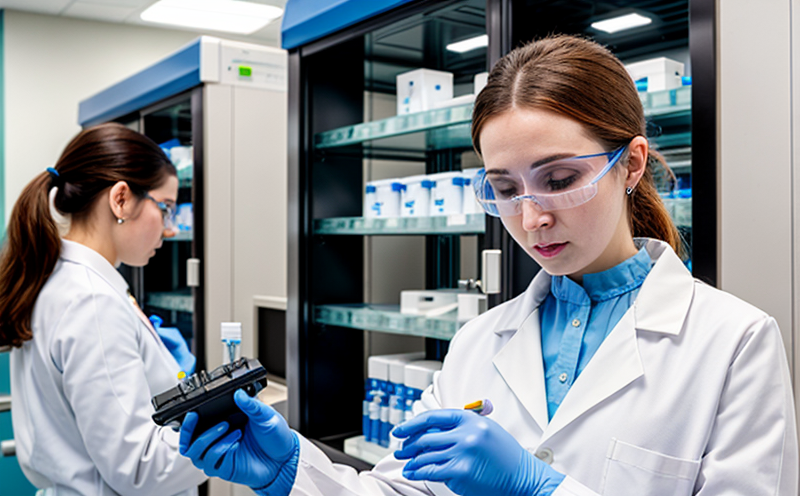Protein Precipitation Sample Prep Testing
The process of protein precipitation is a fundamental technique in bioanalytical testing, widely used to separate proteins from biological samples. This method involves adding an agent that induces the aggregation or precipitation of proteins out of solution, facilitating their isolation and further analysis. Protein precipitation is a critical step in sample preparation for various analytical techniques such as mass spectrometry (MS), liquid chromatography-mass spectrometry (LC-MS/MS), and enzyme-linked immunosorbent assays (ELISAs). This service ensures the integrity of proteins, enabling accurate quantification and identification.
The technique is particularly important in pharmaceutical testing where the purity and stability of active pharmaceutical ingredients (APIs) are paramount. By using protein precipitation, laboratories can effectively remove interfering components, ensuring that the subsequent analysis targets pure samples. This process involves several steps: sample collection, addition of a precipitating agent, incubation, centrifugation to separate the precipitated proteins from the supernatant, and finally, analysis of the resulting precipitate.
The choice of precipitating agent is critical and depends on the nature of the protein. Common agents include ammonium sulfate (NH₄SO₄), trichloroacetic acid (TCA), and acetone. Each has its advantages: NH₄SO₄ is often used for high-salt conditions, TCA provides excellent precipitation efficiency, while acetone helps in maintaining the native structure of proteins during precipitation.
Once precipitated, the protein samples are typically resuspended in a suitable buffer before further analysis. The quality and consistency of this step can significantly impact downstream results. Our laboratory uses advanced equipment to ensure precise control over temperature, pH, and time for optimal sample preparation.
The precision and accuracy of protein precipitation depend on several factors including the type of precipitant used, the concentration, and the incubation time. These parameters are meticulously controlled during our testing process to ensure reproducibility and compliance with international standards such as ISO 17025. The stability of proteins is also monitored throughout the process to avoid denaturation, which could lead to erroneous results.
In conclusion, protein precipitation sample prep testing is a cornerstone in bioanalytical testing, particularly in pharmaceutical R&D environments. By providing accurate and reliable sample preparation services, we ensure that our clients achieve consistent and precise analytical outcomes, critical for drug development and quality assurance.
Industry Applications
Protein precipitation is widely used across various industries, but its role in pharmaceutical testing stands out due to the stringent regulatory requirements. In this sector, protein precipitation helps ensure that APIs are free from contaminants, thus enhancing product safety and efficacy. It also aids in the development of new drugs by facilitating the isolation and characterization of proteins involved in drug metabolism.
Bioanalytical testing, which includes protein precipitation, plays a vital role in compliance with regulations such as those set forth by the International Conference on Harmonisation (ICH). These standards ensure that pharmaceutical products meet quality benchmarks worldwide. Protein precipitation is also crucial in forensic science for DNA extraction and in environmental testing for assessing the presence of proteins indicative of pollution or contamination.
In research laboratories, protein precipitation supports a wide range of studies from basic biology to advanced proteomics. It allows researchers to isolate specific proteins for further analysis, contributing significantly to advancements in fields like genomics, immunology, and biochemistry. The technique is equally important in clinical trials where the purity and integrity of test samples are crucial.
Our laboratory's expertise in protein precipitation aligns perfectly with these diverse applications, providing comprehensive support to pharmaceutical companies, research institutions, and regulatory bodies.
Why Choose This Test
Selecting a reliable and experienced laboratory for your protein precipitation sample prep testing is crucial. Our service offers several advantages that make it an ideal choice:
- Expertise in Precipitation Techniques: We employ skilled technicians who are trained in the latest methods, ensuring accurate and efficient sample preparation.
- Compliance with Standards: All our protocols adhere to international standards such as ISO 17025, guaranteeing high-quality results that meet regulatory requirements.
- Advanced Equipment: Utilizing state-of-the-art instruments allows us to maintain precise control over every aspect of the process, from temperature and pH levels to incubation time.
- Rapid Turnaround Times: By optimizing our workflow, we can deliver results quickly without compromising on accuracy or precision.
- Detailed Reporting: Our reports are comprehensive, providing detailed information about each step of the process, ensuring transparency and traceability.
- Certified Personnel: Our team members undergo continuous training to stay updated with the latest techniques and methodologies.
- Sustainability Practices: We implement environmentally friendly practices throughout our operations, minimizing waste and energy consumption.
Choosing us means leveraging years of experience in sample preparation and bioanalytical testing. Our commitment to excellence ensures that you receive reliable and accurate results every time.
Environmental and Sustainability Contributions
The environmental impact of laboratory operations is a growing concern, and our laboratory takes proactive steps to minimize its footprint. Protein precipitation, while necessary for sample preparation, can generate waste if not managed properly. However, by adopting sustainable practices, we mitigate these impacts:
- Recycling Reagents: We have implemented a system where used reagents are recycled or reused whenever possible.
- Eco-Friendly Precipitants: Where feasible, we use environmentally friendly precipitants that reduce the ecological impact of our operations.
- Energy Efficiency: Our equipment is designed to be energy-efficient, reducing consumption and associated emissions.
- Waste Reduction: By optimizing sample preparation processes, we minimize waste generation. This includes efficient use of reagents and minimal disposal of unused or contaminated materials.
- Training Programs: We offer training programs for clients on how to implement sustainable practices in their own laboratories.
By choosing our laboratory, you are not only ensuring the accuracy and reliability of your protein precipitation sample prep testing but also contributing to a more sustainable future. Our commitment to environmental stewardship is reflected in every aspect of our operations.





